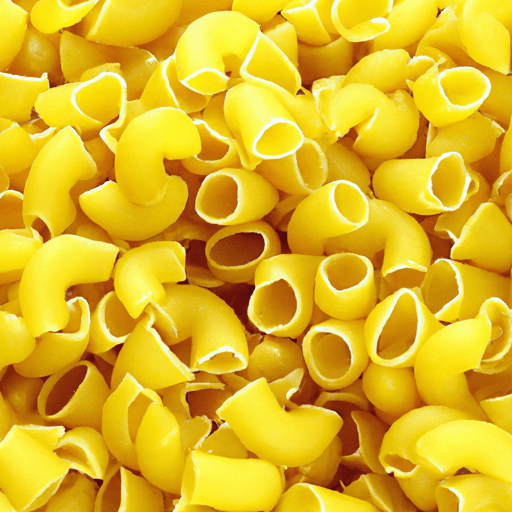A Delectable Delight: Cooked Anellini Noodles
If you are a pasta enthusiast, then you’ve likely come across various types of pasta. One such pasta that might have caught your eye is anellini noodles. These tiny, round-shaped pasta rings are not only visually appealing but also a delight to the taste buds. In this blog post, we will explore the ins and outs of anellini noodles and reveal their secrets from cooking techniques to fascinating historical tidbits.
A Taste of Tiny Rings
Anellini noodles boast a wonderfully tender and chewy texture that creates a delightful mouthfeel. The mild flavor of these pasta rings allows them to serve as an excellent vehicle for absorbing the accompanying flavors of sauces, broths, or other ingredients you choose to pair them with. Their subtle taste pairs well with various seasonings, making them an incredibly versatile pasta option.
Culinary Utilization
Due to their diminutive size, anellini noodles are a popular choice for soups, stews, and casseroles. These little pasta rings effortlessly mingle with other ingredients, enhancing the overall taste and texture of the dish. Their small shape also makes them suitable for kid-friendly meals, as they are easy to handle and enjoyable to eat.
One popular dish featuring anellini noodles is the iconic Italian “Pasta e Fagioli” soup. The tiny rings effortlessly absorb the flavors of the broth, the vegetables, and the beans, resulting in a comforting and satisfying meal.
Nutritional Value
When it comes to nutritional value, anellini noodles offer a decent nutritional profile. As with most pasta, anellini noodles are predominantly composed of carbohydrates. They also contain a moderate amount of protein and fiber. Additionally, anellini noodles are low in fat, making them a suitable option for those watching their fat intake.
A Peek into History
While uncovering the origin of anellini noodles, we find ourselves traversing the vast culinary landscape of Italy. Originating from the southern region of Sicily, anellini noodles have become a staple in Italian cuisine. Their unique shape and texture have captivated chefs and home cooks alike for generations.
Interestingly, anellini noodles are often associated with celebrations and festive occasions in Sicilian cuisine. They are frequently featured in traditional dishes during holidays and family gatherings, adding a touch of joy and festivity to the table.
Fun Facts
- The name “anellini” comes from the Italian word “anello,” meaning ring, perfectly describing their circular shape.
- Anellini noodles are not only loved in Italy but have gained popularity in other parts of the world, particularly in countries with a significant Italian influence.
In conclusion, anellini noodles may be small in size, but they certainly pack a flavorful punch. They offer a delightful culinary experience, especially when incorporated into soups, stews, and casseroles. With their versatile nature and fascinating history, these petite pasta rings are a fantastic addition to any pantry. So go ahead, explore the world of anellini noodles and let your creativity soar in the kitchen!
Anellini Noodles
Origin and Common Uses:
- Anellini noodles are small, ring-shaped pasta that originated in Italy. “Anellini” is the plural form of “anellino,” which means “little ring” in Italian.
- Anellini noodles are commonly used in Italian cuisine, especially in traditional Sicilian dishes.
- They are often used in soups or pasta salads, as well as in baked dishes like pasta al forno (oven-baked pasta).
- In Sicily, anellini noodles are a key ingredient in the popular dish “pasta alla Norma,” which combines the noodles with eggplant, tomato sauce, and grated cheese.
Nutritional Benefits:
- Anellini noodles are typically made from durum wheat semolina, which provides a good amount of complex carbohydrates.
- They are relatively low in fat and cholesterol, making them a healthy option when paired with nutritious ingredients such as vegetables and lean proteins.
- Anellini noodles also contain some dietary fiber, which can contribute to a healthy digestive system.
Unique Properties and Historical Significance:
- Due to their small ring shape, anellini noodles can be visually appealing and add an interesting twist to pasta dishes.
- The historical significance of anellini noodles lies in their use in traditional Sicilian cuisine, where they have been enjoyed for centuries.
- Sicilian immigrants brought the tradition of anellini noodles to countries like the United States, where these noodles are still consumed as a symbol of cultural heritage.
- While anellini noodles are a unique pasta shape, they can be substituted with other small pasta shapes like pastina or ditalini if anellini noodles are not readily available.
Please note that even though anellini noodles can be a healthy part of a balanced diet, individual nutritional needs may vary. It’s always important to consider personal dietary restrictions and health conditions when incorporating ingredients into your meals.




Use the share button below if you liked it.
It makes me smile, when I see it.